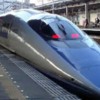Kingfishers differ from many other birds because of their long beaks and large heads.The upper and lower parts of the beak have triangular cross-sections with curved sides, forming a compressed diamond shape. This allows the kingfisher to dive headfirst into water at high speed, while making minimal splash.
This capability has inspired engineers dealing with issues around the use of Japan's famous bullet trains.
Bullet trains are a common method of transportation in Japan, forming a network of high-speed railway lines where trains reach speeds up to 320 km per hour and carry hundreds of millions of passengers each year.
Japanese engineers originally had a problem. Originally modelled on the round shape of a bullet, the trains caused a very loud sound when exiting tunnels, disturbing people and wildlife in the process.
The trains created atmospheric pressure waves, causing cushions of air to build up at the front of each train. As the train exited the tunnel, it forced the air out, creating a huge boom.
A group of engineers came together, and in the group was a birdwatcher Eiji Nakatsu. He had seen Kingfishers dive into the water in near silence and wondered if the basics of their design could be adapted to high-speed trains.
This idea was incorporated into the research. They developed a sleek, beak-like shape. This design, inspired by the kingfishers-did not push a wave of air out in front of the train, just as the kingfisher in a dive does not displace large amounts of water when it breaks the surface.
As an added bonus, the new design-still used today-allows the trains to travel even faster and reduce energy consumption by 15%.
Information from Canadian Wildlife


 Thank you Vicky for the images.
Thank you Vicky for the images.
